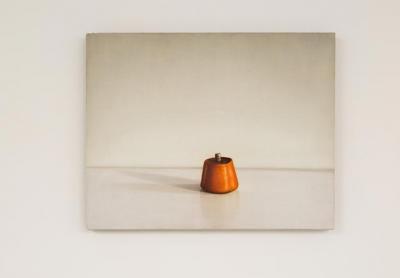Royce Weatherly's Painterly Derring-Do

Last Thursday morning, Royce Weatherly walked into the Watermill Center carrying a handful of long grasses he had found on a walk. They were evidence of the artist’s interaction with the South Fork environment since his arrival this month.
Mr. Weatherly is a fellow at the center, one of the early recipients of a grant from Inga Maren Otto that established a fellowship for visual artists there. A studio room on the second floor has light and space for him to set up small tableaux and store the collection of stones, feathers, and other objects he has found here that might serve as subjects or inspirations for his paintings.
Elsewhere in the center, a mini survey of his finished work hangs in formal and surprising ways. “Looking Slowly: 30 Years of Painting” is a mostly borrowed show of his characteristically small canvases, measuring anywhere from 14 to 21 inches in height and width.
He paints only a few works a year. Having held a number of day jobs, including being an art handler at the Whitney Museum of American Art and a set builder for Martha Stewart, he said there are times he is too busy or tired to work on art. His practice of repeatedly going over the subjects and backgrounds of his paintings in very thin layers of oil paint also adds to the delay. “It takes me around 90 sittings to complete a painting and that can take anywhere from two to six months” depending on other de mands on his time.
Some might call his approach photorealism, but it is really a kind of heightened naturalism, and his choice of modest objects have attracted a loyal following of collectors who, judging by the wall labels, like to acquire his paintings in multiples, similar to how the devout collect icons.
The artist and his work carry a lot of contradictions, which only enrich the experience of his paintings. Light comes from multiple sources. Some objects, like cellophane, seem to be feats of painterly derring-do, the height of a tradition of artists laying down a bravura challenge to themselves or others in a spirit of competition that goes back to the Renaissance.
Speaking of the Renaissance, Mr. Weatherly said a Durer nature study had been lately occupying his mind, the grasses in his hand bearing close resemblance to some of the unsung subjects, including dandelions, that the German master had elevated in his paintings from more than 500 years ago.
His subjects in general are a mix of natural and man-made, and tend toward the humble and overlooked. Having enjoyed an egg sandwich from Hampton Coffee one morning, he said the crinkled foil packets of ketchup at the bottom of the bag struck his interest, but in a formal and emotionally neutral way.
Black walnuts, one of his earliest subjects, are often found littering the ground, more of a nuisance than a prize. He shared that his mother used the walnuts to make pound cakes and cookies at Christmastime in his native North Carolina. For him, the walnuts are a stand-in for his mother in a painting he made for her and now keeps after her death.
In a painting of a seashell and a potato he made for his wife, he noted the symbolism of the objects. His wife has spent most of her life on the coast, and the ocean remains important to her. He grew up near farmland where potatoes grow. It’s a lovely self-portrait that has a serendipitous resonance on the South Fork.
If such sentiment is too warm and fuzzy for some, his more clinical examinations, such as “Worklights” from 2012, “Widget” from 2013, and “Bupkis” make up for it. “Bupkis,” whose literal meaning is “nothing at all,” is a diner paper cup of coffee, empty save for a drop along the seam of its interior, lying on its side next to the discarded cellophane of a cigarette wrapper. The cellophane is a gossamer parallelogram, its transparency built from the thinnest of paint layers capturing pockets of shadow and glimmers of light.
The empty cellophane wrapper is a repeating motif in his work. Having grown up in tobacco country, the visual signifiers of cigarettes are part of his nurture and perhaps his nature as well.
“Twilight,” which might be considered a companion piece, is an examination of an old-fashioned cigarette lighter in full flame. Rather than floating in space, this single object is placed on a surface in a defined background with a seam to the rear and imperfections that suggest paint or plaster buckling where a wall intersects the floor or the end of a table. As detailed as the finish and soot of the lighter are presented, the flame is an abstraction, casting dusky colors and shadows below it.
Often compared to Vermeer or Dutch still-life virtuosos, one can see it in the handling of his cellophane, but Mr. Weatherly’s light moves around, comes from multiple places in some cases, and can’t be relied upon for consistency. A painting from 1988 alluding to Rembrandt’s lighting may offer the most evidence in favor of such comparisons, but his recent work proves more problematic.
As faithfully as he renders some objects in space, others, such as the three balls in “Diminished Basic” from 2013, are rendered flatly, slightly curved, but hardly in the round. “Sticky Bun” also seems more like an object painted from memory than from direct observation. The spareness of these exercises ally him more closely with modern masters like Morandi, whose spare and generalized still lifes are recalled in these works.
The exhibition is on view through Oct. 11 by appointment or during this weekend’s events (Click for Watermill Center's events).
